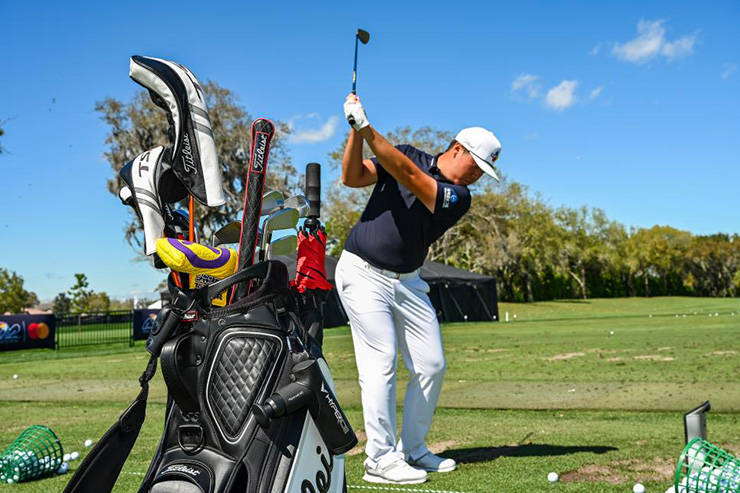We all want to play like tour pros. We know we can’t, but even a single shot can inch us closer—a piped drive, a staked approach, a nipped chip or even the occasional 40-footer. Often we regard these as happy accidents, but there are ways to make them a more common occurrence. Below are nine things that you can learn from tour pros about equipment. They won’t leave you with a reserved parking spot at the next tour event, but they’ll have you hitting quality shots more often.
Get fit for your clubs
We beat you over the head with this topic, but there’s a reason for it. Every single tour player gets fit for their clubs and to those who say they’re not good enough for it to matter, we say you’re just digging yourself a bigger hole. You can’t play good golf with tools ill-fitted to you. And while you’re getting fit, don’t forget the putter, which might be the most poorly fit club in your bag. Finally, a couple of pro tips on fitting: always bring your gamer as a baseline. Never assume the 1-degree up spec you had on your last irons are good for your next set because every company’s specs are different. Also, get fit frequently. Your body, your swing or both can change over time.
More 7-woods, please
Golf Digest wrote about the 7-wood surge on tour earlier this year and you should take note. On any given week 20 to 25 percent of the PGA Tour have a 7-wood in the bag. Why? They’ve found they go higher, land softer, plow through rough easier and are generally easier to hit than a hybrid or long iron. We’re thinking all those things might appeal to you.
RELATED: 7-woods are all the rage for good reason. Should the 9-wood be next?
If you can’t stomach the 7-wood, at least use utility irons
OK, we know some people simply aren’t going to go with the 7-wood. Or even a hybrid. But tour pros have eschewed conventional long irons for utility irons at a pretty significant rate in recent years. That’s a trend you should follow if you insist on carrying long irons. The added heft on the sole will help get some air under those shots and most sport springy cup or L-faces that will add some pop to those shots. As we said, we like 7-woods or even hybrids better, but this is the next best option.
RELATED: Beware when shopping for new irons: All specs are not the same
Also, more mallets
Sure, the Ping Anser-style blade putter has been a fixture on PGA Tour greens for more than half a century and as such has found its way into the bags of countless everyday players. But there’s a reason about half of tour players are using mallets. Simply put, they work. The larger heads offer better stability on mis-hits and the alignment features prove fruitful, making the Odyssey 2-Ball, TaylorMade Spider, Scotty Cameron Phantom and Ping Tyne series, among others, popular at the elite level. Tour pros have won millions with these clubs. Give a mallet a try and that $5 Nassau might finally start coming your way. Your Venmo account thanks us.
Carry four or even five wedges
If you’re still carrying a set of clubs where the only wedges you have say P and S then you are in dire need of help. The high majority of tour pros carry four wedges (including pitching wedge) and some even go with five. Surely you’re thinking that’s because they bomb the ball ungodly distances and, well, that’s true. But think about your game. It doesn’t matter if your second shot is between 50 and 125 yards (tour pro) or your third shot (you). You need a club for that yardage. Plus, you’re not as adept at the half shot as a tour pro. Also, the dirty little secret of iron sets is that the loft gaps at the long end are more compressed (often only 3 degrees between a 4- and 5-iron) and more spaced out on the short end (4 or 5 degrees). As such, you can ditch that 4-iron to add another wedge because you’re probably hitting your 5-iron about the same distance. And don’t be afraid to use the gap wedge that comes with your set. Sam Burns, Dylan Fritellli, Stewart Cink, Brendan Steele and Lee Westwood all use set gap wedges. If it’s good enough for them . . .
Beware the stiff shaft
When we ask tour players what the No. 1 mistake their pro-am partners make, shafts that are too stiff are often mentioned. A more flexible shaft can help you get through the ball and probably add some height to your shot while you’re at it. We’re guessing both of those are things that many of you could use in your game.

Streeter Lecka
Use the adjustable feature in your driver
Most everyday golfers, even if they get fit—heck, especially if they get fit—rarely try another setting after that. Big mistake. When Charles Howell III gets a new driver he tries it in all possible settings. Why? “One thing I’ve learned to do is that I change it everywhere I can, even in settings I know I likely will never end up playing,” Howell told Golf Digest. “I just want to see what it does in case I ever need to put it in that setting.” In other words, take a wrench and a bucket of balls to the range and try different settings. You just might find that there is one that might prove even more beneficial. You might be amazed at how a degree of loft or face angle might positively impact your game. Plus, there’s zero downside to trial and error. After all, the great thing about an adjustable driver is that you can always put it back to the setting you originally had.
Ball fitting around the green
Ah, you thought you were done listening to us tout fitting. Not so fast, my friend. Ball fitting is important, too. First step: We don’t see tour pros playing two-piece Surly-covered golf balls. Now before you yell at us for trying to upsell you, if you’re losing a sleeve a round or more, we get it. Carry on until you get better. But if you’re keeping it between the white lines, listen up. You need a multilayer, urethane-covered ball just like the pros use. Its performance into and around the greens is just undeniably better. But which one? Titleist and Callaway have three of those (and that’s not counting specialty models). Bridgestone has four. TaylorMade has two. Srixon has multiple models as well. While everyone would like a few extra yards, these balls are all very close to each other in the distance game. As such, work with them from 125 yards and in and especially around the green, where you are likely to see the biggest differences. Don’t believe me? Take it from the man himself, Tiger Woods, who’s final sanity check when choosing a golf ball is its trajectory on chip shots. I kid you not.
RELATED: How do I determine which golf ball is right for me?
Be prepared for bad weather
Most recreational golfers hate playing in bad weather. In fact, a drop of rain and those folks are staying home. Some of it has to do with not wanting to get wet, but mainly it’s because the game becomes more difficult. Why’s that? Because everyday golfers fail to come prepared for the elements. Bottom line is there’s more to being prepared to play golf in bad weather than having an umbrella in the bag. It’s having a rain suit to keep your shirt and pants—and therefore you—fairly dry. Rain gloves as well, to enhance your grip. A towel over your clubs and another in the bag in case the first one gets too wet can prove helpful, although a waterproof cover for the top of the bag is even better. In short, keeping your clubs dry is more important than keeping you dry. And yes, we know you don’t have a caddie to lug all this crap around on a sunny day, but at least keep it in the car for when the need arises. As Tom Watson, one of the best bad weather players in history, said after a rainy round at the 2011 British Open, “You just try to do the best you can to keep your grips dry and your wits about you.” Adopt these tips—and Watson’s mindset—and seeing a little rain out the window will have you excited to play because you’ll be 2 up on everyone else.
Main image: Keyur Khamar









